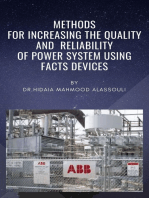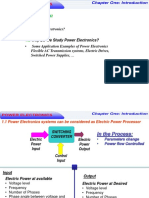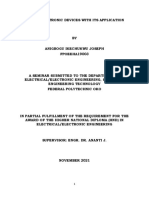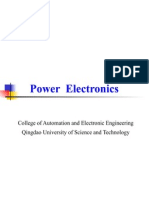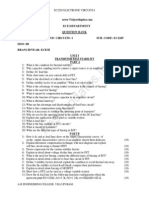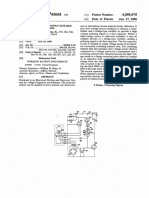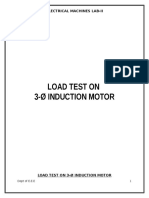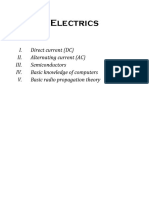Department of Department of Electronics & Electrical Engineering Electronics & Electrical Engineering
Uploaded by
Sunil KumarDepartment of Department of Electronics & Electrical Engineering Electronics & Electrical Engineering
Uploaded by
Sunil KumarEIectronics & Communicution Engineering
Indian Institute of Technology Guwahati
Department of Department of
Electronics & Electrical Engineering Electronics & Electrical Engineering
EIectronics & Communicution Engineering
Inlroduclion
y
Indian Institute of Technology Guwahati
y
Dr. Iraveen Kumar
Assislanl Irofessor
Dearlmenl of IIeclronics & IIeclricaI Ingineering
EIectronics & Communicution Engineering
Introduction Introduction
The goal of an energy conversion process is to best serve the needs of a customer.,
while supporting highly efficient generation and transport of energy
A few subdisciplines of electrical engineering, with their conversion roles are:
1. Signal Process: The engineers consider conversion between information and
electricity.
Indian Institute of Technology Guwahati
electricity.
2. Antenna: The effort is to develop most efficient and reliable ways to convert the
energy in electromagnetic waves into circuit currents and voltages.
3. Electromechanics: The engineers consider conversion between mechanical and
electrical energy forms.
4. Quantum electronics: The engineers often concern themselves with the
interaction of optical signals with electric circuits.
EIectronics & Communicution Engineering
What is Power Electronics What is Power Electronics
Power electronics deals with conversion and control of electrical power with the help
of electronic switching devices.
The magnitude of power may vary widely, ranging from a few watts to several
gigawatts.
Indian Institute of Technology Guwahati
The specific definition of power electronics is:
Power electronics involves study of electronic circuits intended to control flow of
electrical energy. These circuits handle power flow at levels much higher than the
individual device ratings.
In Fig.1, the subject of power electronics represents a median point combining topics
in energy systems, electronics and control.
EIectronics & Communicution Engineering
Introduction Introduction
Power
Electronics
Indian Institute of Technology Guwahati
Electronics and
Devices
Circuits
Power
Semiconductors
Magnetics
Fig.1: Power Electronics
EIectronics & Communicution Engineering
Need for Electrical Conversion Need for Electrical Conversion
For many applications electrical energy in various forms is needed. Examples of such
forms are:
1. Voltage Level Conversion: Some systems not only need multiple levels of voltage
but it often requires them to be mutually isolated so that their loads remain
separate.
2. Frequency Conversion: Rectification is an example of frequency conversion.
Indian Institute of Technology Guwahati
2. Frequency Conversion: Rectification is an example of frequency conversion.
Another example is conversion between the 50Hz systems used in about half the
world and the 60Hz system used in the other half.
3. Waveshape Conversion: Sinusoidal waveforms for power minimize interference
with frequency multiplexed communication systems. However, sine waves are not
always best for power conversion for motors. Square or trapezoida; waves are
used in some motors.
4. Polyphase conversion: Phase conversion is frequently required in motor drives
for improving motor efficiency, improving torque ripples, etc.
EIectronics & Communicution Engineering
Application Areas of Power Application Areas of Power
Electronics (Wind Energy) Electronics (Wind Energy)
Indian Institute of Technology Guwahati
Fig1: A typical wind energy conversion system
(Ref: Blaabjerg F., et.al., Power Electronics in Wind Turbine Systems,
IEEE 5
th
International Power Electronics and Motion Control Conference)
EIectronics & Communicution Engineering
Application Areas of Power Application Areas of Power
Electronics (HEV) Electronics (HEV)
Tracti
on
Mech.
Trans.
Engine
Fuel tank
Generat
or
AC
DC
DC
Indian Institute of Technology Guwahati
Fig2: A typical HEV configuration
on
motor
Trans.
Engine
Battery
pack
or
DC
DC
DC
3~ AC
AC
DC
EIectronics & Communicution Engineering
Application Areas of Power Application Areas of Power
Electronics (EV) Electronics (EV)
Electronic
controller
Mechanical
transmission
Wheel
Wheel
Brake
Accelerator
Electric propulsion subsystem
3-phase
AC motor
3-phase
PWM
inverter
Indian Institute of Technology Guwahati
Fig3: A typical EV configuration
Energy
management
unit
Battery
Pack
Auxiliary
Power
Supply
Power
steering
unit
Energy
refueling
unit
Temperature
control
unit
Energy source
subsystem
Auxiliary subsystem
Steering
wheel
EIectronics & Communicution Engineering
Application Areas of Power Application Areas of Power
Electronics (Railways) Electronics (Railways)
Indian Institute of Technology Guwahati
Fig4: Railway Application
(Ref: Power Electronics Transformers of ABB)
EIectronics & Communicution Engineering
Application Areas of Power Application Areas of Power
Electronics (Smart Grid) Electronics (Smart Grid)
Indian Institute of Technology Guwahati
Fig5: Smart Grids
EIectronics & Communicution Engineering
Application Areas of Power Application Areas of Power
Electronics Electronics
Indian Institute of Technology Guwahati
EIectronics & Communicution Engineering
Ratings of Power electronics Ratings of Power electronics
Components Components
Indian Institute of Technology Guwahati
EIectronics & Communicution Engineering
Power Electronics vs. Linear Power Electronics vs. Linear
Electronics Electronics
A typical power conversion system is shown in Fig.2. The objective of power
conversion system is to achieve a high energy efficiency because of two reasons:
1. The cost of wasted energy and the difficulty in removing the heat generated due to
dissipated energy.
Indian Institute of Technology Guwahati
2. Reduction in size, weight and cost can be achieved if the efficiency is higher.
The above objective in most systems cannot be met by linear electronics where the
semiconductor devices are operated in their linear (active) region and a line frequency
transformer is used for electrical isolation.
An example of a system involving linear electronics principle is shown in Fig.3a. The
goal of this power supply is to deliver a regulated output voltage to a load.
( )
o
V
EIectronics & Communicution Engineering
Power Electronics vs. Linear Power Electronics vs. Linear
Electronics Electronics
Power
Processor
Load
Power Input
Power Output
i
v
i
i
o
i o
v
Indian Institute of Technology Guwahati
Controller
Control Signals
Measurements
Reference
Fig.3a: Block diagram of a power electronics system
EIectronics & Communicution Engineering
Power Electronics vs. Linear Power Electronics vs. Linear
Electronics Electronics
Controller
Line frequency
transformer
+
R
+
Indian Institute of Technology Guwahati
Fig.3a: Linear dc power supply
Filter
Capacitor
Rectifier
d
v
-
load
R
-
o
V
, o ref
V
Utility supply
EIectronics & Communicution Engineering
Power Electronics vs. Linear Power Electronics vs. Linear
Electronics Electronics
Indian Institute of Technology Guwahati
Fig.3b: Voltage waveform
EIectronics & Communicution Engineering
Power Electronics vs. Linear Power Electronics vs. Linear
Electronics Electronics
In Fig.3a the utility supply may be at 120 or 240V and the output voltage may be
5V. It is required that the output is electrically isolated from the utility input.
A line frequency transformer is used to provide electrical isolation and for stepping
down the line voltage.
( )
o
V
Indian Institute of Technology Guwahati
The rectifier converts the alternating current output of the transformer low voltage
winding into dc.
The filter capacitor reduces the ripple ,in the dc voltage .The waveform of the
is shown in Fig.3b.
The transformer turns ratio must be so chosen that the minimum of the input voltage
is greater than the desired output voltage
( )
d
V
d
V
d
V
o
V
EIectronics & Communicution Engineering
Power Electronics vs. Linear Power Electronics vs. Linear
Electronics Electronics
For the range of the input voltage waveforms shown in Fig.3b, the transistor is
controlled to absorb the voltage difference between and , thus providing a
regulated output.
The transistor operates in its active region as an adjustable resistor, resulting in a low
energy efficiency. The line frequency transformer is relatively large and heavy.
d
V
o
V
Indian Institute of Technology Guwahati
energy efficiency. The line frequency transformer is relatively large and heavy.
In power electronics, the regulated voltage is obtained using a circuit shown in
Fig.4a.
In the system shown in Fig.4a, the utility input is rectified into a dc voltage ,
without the line frequency transformer.
By operating the transistor as a switch at some high frequency , the voltage is
converted into an ac voltage at the switching frequency.
o
V
d
V
s
f
d
V
EIectronics & Communicution Engineering
Power Electronics vs. Linear Power Electronics vs. Linear
Electronics Electronics
Indian Institute of Technology Guwahati
Fig.4a: Switched mode dc power supply
EIectronics & Communicution Engineering
Power Electronics vs. Linear Power Electronics vs. Linear
Electronics Electronics
The high frequency ac voltage enables use of a high-frequency transformer to be used
for stepping down the voltage and for providing the electrical isolation.
In order to simplify the circuit for analysis, the transformer is dropped . The simplified
circuit is shown inFig.4b.
Indian Institute of Technology Guwahati
The transistor-diode combination can be represented by a hypothetical two position
switch shown in Fig.5a.
The switch is in position a during the interval when the transistor is on and in
position b when the transistor is off during .
The voltage equals and zero during and respectively (Fig.5b).
on
t
off
t
( )
oi
v t
d
V
on
t
off
t
EIectronics & Communicution Engineering
Power Electronics vs. Linear Power Electronics vs. Linear
Electronics Electronics
Indian Institute of Technology Guwahati
Fig.4b: Simplified circuit of switched mode dc power supply
EIectronics & Communicution Engineering
Power Electronics vs. Linear Power Electronics vs. Linear
Electronics Electronics
Mathematically the voltage can be expressed as
(1)
In eq.1, is the average dc value of and the instantaneous ripple voltage
is shown in Fig.5c.
( )
oi
v t
( ) ( )
oi oi ripple
v t V v t = +
oi
V
( )
oi
v t
ripple
v
Indian Institute of Technology Guwahati
is shown in Fig.5c.
The L-C elements form a low pass filter that reduces the ripple in the output voltage
and passes the average of the input voltage, so that
(2)
where
is the average output voltage
o oi
o
V V
V
=
EIectronics & Communicution Engineering
Power Electronics vs. Linear Power Electronics vs. Linear
Electronics Electronics
From the waveform in Fig.5b it can be seen that
(3)
As the input voltage changes with time, eq.3 shows that it is possible to regulate
0
1
( )
s
T
on
o oi d
s s
t
V v t dt v
T T
= =
o
V
d
v
Indian Institute of Technology Guwahati
at its desired value by controlling the ratio .
The ratio is called the duty ratio D of the transistor switch.
Usually the time interval is kept constant and the on period is varied
on
s
t
T
1
s
s
T
f
=
on
t
on
s
t
T
EIectronics & Communicution Engineering
Power Electronics vs. Linear Power Electronics vs. Linear
Electronics Electronics
Indian Institute of Technology Guwahati
Fig.5b: Voltage waveform
Fig.5a: Hypothetical two position switch
EIectronics & Communicution Engineering
Power Electronics vs. Linear Power Electronics vs. Linear
Electronics Electronics
Fig.5c: Ripple Voltage
Indian Institute of Technology Guwahati
Fig.5d: Voltage waveform
Fig.5c: Ripple Voltage
EIectronics & Communicution Engineering
Power Electronics vs. Linear Power Electronics vs. Linear
Electronics (Observations) Electronics (Observations)
From the waveform in Fig.5b it can be seen that the transistor operates as a switch and
hence its power loss is minimized.
At high switching frequencies, the transformer and the filter components are very
small in weight and size compared with line frequency components.
Indian Institute of Technology Guwahati
You might also like
- Power Electronics Principles and ApplicationsNo ratings yetPower Electronics Principles and Applications5 pages
- BIOBASE Constant-Temperature Incubator BJPX-H30'48'64'123'230II User Manual 20200867% (3)BIOBASE Constant-Temperature Incubator BJPX-H30'48'64'123'230II User Manual 20200814 pages
- Introduction to Electricity Supply and Regulation in IndiaFrom EverandIntroduction to Electricity Supply and Regulation in IndiaNo ratings yet
- Methods for Increasing the Quality and Reliability of Power System Using FACTS DevicesFrom EverandMethods for Increasing the Quality and Reliability of Power System Using FACTS DevicesNo ratings yet
- 1.1 Power Electronics Defined: Philip T. Krein, PH.DNo ratings yet1.1 Power Electronics Defined: Philip T. Krein, PH.D1 page
- Power Electronic Devices With Its ApplicationNo ratings yetPower Electronic Devices With Its Application12 pages
- Power Electronics: Faculty-In-Charge: Dr. Sitangshu BhattacharyaNo ratings yetPower Electronics: Faculty-In-Charge: Dr. Sitangshu Bhattacharya27 pages
- Gujarat Technological University: W.E.F. AY 2018-19No ratings yetGujarat Technological University: W.E.F. AY 2018-194 pages
- Utility Applications of Power ElectronicsNo ratings yetUtility Applications of Power Electronics28 pages
- Introduction To Power Electronics 9781608077199 1608077195 9781608077205 - CompressNo ratings yetIntroduction To Power Electronics 9781608077199 1608077195 9781608077205 - Compress200 pages
- l1 Introduction To Power Electronics 130627131834 Phpapp02 PDFNo ratings yetl1 Introduction To Power Electronics 130627131834 Phpapp02 PDF15 pages
- l1 Introduction To Power Electronics 130627131834 Phpapp02 PDF100% (1)l1 Introduction To Power Electronics 130627131834 Phpapp02 PDF15 pages
- Performance Enhanced Multi-Source Inverter for Hybrid Energy Storage Systems in Electric Vehicle AppNo ratings yetPerformance Enhanced Multi-Source Inverter for Hybrid Energy Storage Systems in Electric Vehicle App28 pages
- Malviya National Institute of Technology Jaipur, RajasthanNo ratings yetMalviya National Institute of Technology Jaipur, Rajasthan47 pages
- Power Electronics-An Emerging Technology - B.K.BoseNo ratings yetPower Electronics-An Emerging Technology - B.K.Bose8 pages
- 1.1 Introduction to Power Electronics_2025No ratings yet1.1 Introduction to Power Electronics_202530 pages
- Mandal - Power Electronics-MC GRAW HILL INDIA (2014)No ratings yetMandal - Power Electronics-MC GRAW HILL INDIA (2014)891 pages
- Marcus Haeusler CIGRE SC B4 Expert Selection Criteria For VSC HVDC System SolutionsNo ratings yetMarcus Haeusler CIGRE SC B4 Expert Selection Criteria For VSC HVDC System Solutions25 pages
- Lytswitch-6 Family: Flyback CV/CC Led Driver Ic With Integrated 650 V / 725 V Mosfet and Fluxlink FeedbackNo ratings yetLytswitch-6 Family: Flyback CV/CC Led Driver Ic With Integrated 650 V / 725 V Mosfet and Fluxlink Feedback32 pages
- Variable DC Power Supply: Ac Machines (Lab) DescriptionNo ratings yetVariable DC Power Supply: Ac Machines (Lab) Description4 pages
- An Efficient Bridgeless Power Factor Correction Boost ConverterNo ratings yetAn Efficient Bridgeless Power Factor Correction Boost Converter5 pages
- O&m - Manual - 220V - 187 Ah Plante Battery PDF100% (1)O&m - Manual - 220V - 187 Ah Plante Battery PDF16 pages
- Modulation Strategies For Three-Phase AC-DC Matrix Converters A ComparisonNo ratings yetModulation Strategies For Three-Phase AC-DC Matrix Converters A Comparison7 pages
- DESIGN AND CONSTRUCTION OF 5KVA INVERTER Electrical Engineering Projec...No ratings yetDESIGN AND CONSTRUCTION OF 5KVA INVERTER Electrical Engineering Projec...12 pages
- A Survey On Neutral Point Clamped Multi Level InverterNo ratings yetA Survey On Neutral Point Clamped Multi Level Inverter12 pages
- New Unidirectional Five-Level VIENNA Rectifier For High-Current ApplicationsNo ratings yetNew Unidirectional Five-Level VIENNA Rectifier For High-Current Applications6 pages
- TP48200B-N20A5 N20A6 L20A5 Indoor Integrated Power System Datasheet PDFNo ratings yetTP48200B-N20A5 N20A6 L20A5 Indoor Integrated Power System Datasheet PDF2 pages
- Immediate download Power Converter Circuits Electrical and Computer Engineering 1st Edition William Shepherd ebooks 2024100% (7)Immediate download Power Converter Circuits Electrical and Computer Engineering 1st Edition William Shepherd ebooks 202469 pages
- Technical Application Papers Nº5-ABB Circuit Breakers For DC ApplicationsNo ratings yetTechnical Application Papers Nº5-ABB Circuit Breakers For DC Applications56 pages
- Unit-4 Static Relays (Switchgear and Protection)No ratings yetUnit-4 Static Relays (Switchgear and Protection)54 pages
- BHEL Report On Transformer.f (PDF) .Final1100% (1)BHEL Report On Transformer.f (PDF) .Final145 pages
- BIOBASE Constant-Temperature Incubator BJPX-H30'48'64'123'230II User Manual 202008BIOBASE Constant-Temperature Incubator BJPX-H30'48'64'123'230II User Manual 202008
- Introduction to Electricity Supply and Regulation in IndiaFrom EverandIntroduction to Electricity Supply and Regulation in India
- Methods for Increasing the Quality and Reliability of Power System Using FACTS DevicesFrom EverandMethods for Increasing the Quality and Reliability of Power System Using FACTS Devices
- 1.1 Power Electronics Defined: Philip T. Krein, PH.D1.1 Power Electronics Defined: Philip T. Krein, PH.D
- Power Electronics: Faculty-In-Charge: Dr. Sitangshu BhattacharyaPower Electronics: Faculty-In-Charge: Dr. Sitangshu Bhattacharya
- Gujarat Technological University: W.E.F. AY 2018-19Gujarat Technological University: W.E.F. AY 2018-19
- Introduction To Power Electronics 9781608077199 1608077195 9781608077205 - CompressIntroduction To Power Electronics 9781608077199 1608077195 9781608077205 - Compress
- l1 Introduction To Power Electronics 130627131834 Phpapp02 PDFl1 Introduction To Power Electronics 130627131834 Phpapp02 PDF
- l1 Introduction To Power Electronics 130627131834 Phpapp02 PDFl1 Introduction To Power Electronics 130627131834 Phpapp02 PDF
- Performance Enhanced Multi-Source Inverter for Hybrid Energy Storage Systems in Electric Vehicle AppPerformance Enhanced Multi-Source Inverter for Hybrid Energy Storage Systems in Electric Vehicle App
- Malviya National Institute of Technology Jaipur, RajasthanMalviya National Institute of Technology Jaipur, Rajasthan
- Power Electronics-An Emerging Technology - B.K.BosePower Electronics-An Emerging Technology - B.K.Bose
- Analog Dialogue, Volume 46, Number 3: Analog Dialogue, #7From EverandAnalog Dialogue, Volume 46, Number 3: Analog Dialogue, #7
- Mandal - Power Electronics-MC GRAW HILL INDIA (2014)Mandal - Power Electronics-MC GRAW HILL INDIA (2014)
- Marcus Haeusler CIGRE SC B4 Expert Selection Criteria For VSC HVDC System SolutionsMarcus Haeusler CIGRE SC B4 Expert Selection Criteria For VSC HVDC System Solutions
- Lytswitch-6 Family: Flyback CV/CC Led Driver Ic With Integrated 650 V / 725 V Mosfet and Fluxlink FeedbackLytswitch-6 Family: Flyback CV/CC Led Driver Ic With Integrated 650 V / 725 V Mosfet and Fluxlink Feedback
- Variable DC Power Supply: Ac Machines (Lab) DescriptionVariable DC Power Supply: Ac Machines (Lab) Description
- An Efficient Bridgeless Power Factor Correction Boost ConverterAn Efficient Bridgeless Power Factor Correction Boost Converter
- Modulation Strategies For Three-Phase AC-DC Matrix Converters A ComparisonModulation Strategies For Three-Phase AC-DC Matrix Converters A Comparison
- DESIGN AND CONSTRUCTION OF 5KVA INVERTER Electrical Engineering Projec...DESIGN AND CONSTRUCTION OF 5KVA INVERTER Electrical Engineering Projec...
- A Survey On Neutral Point Clamped Multi Level InverterA Survey On Neutral Point Clamped Multi Level Inverter
- New Unidirectional Five-Level VIENNA Rectifier For High-Current ApplicationsNew Unidirectional Five-Level VIENNA Rectifier For High-Current Applications
- TP48200B-N20A5 N20A6 L20A5 Indoor Integrated Power System Datasheet PDFTP48200B-N20A5 N20A6 L20A5 Indoor Integrated Power System Datasheet PDF
- Immediate download Power Converter Circuits Electrical and Computer Engineering 1st Edition William Shepherd ebooks 2024Immediate download Power Converter Circuits Electrical and Computer Engineering 1st Edition William Shepherd ebooks 2024
- Technical Application Papers Nº5-ABB Circuit Breakers For DC ApplicationsTechnical Application Papers Nº5-ABB Circuit Breakers For DC Applications












